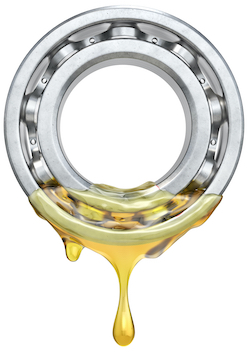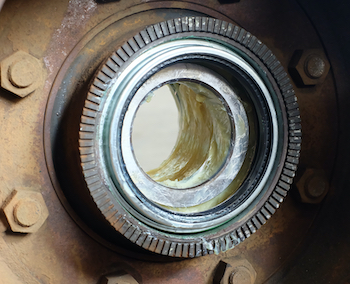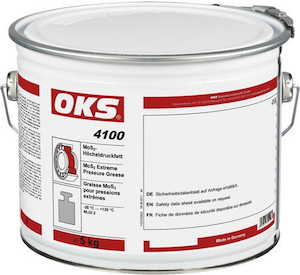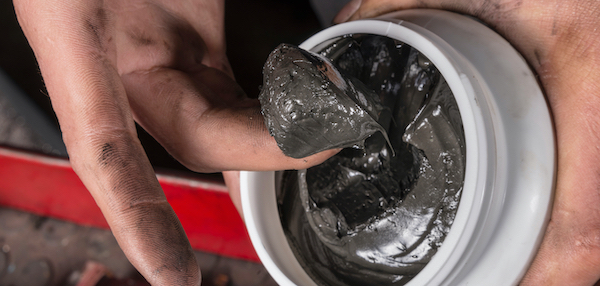Bearing Lubricant Overview

Figure 1: Lubricating bearings"
Bearings are made out of rollers and bearing rings. During operation, the rollers slide inside the rings. This makes it the source of friction and the point where failure usually occurs. By applying bearing lubricant between these surfaces, the heat generated by friction is reduced, ensuring a longer lifespan for the bearing. Besides this, lubricants provide other advantages such as preventing contamination, heat dissipation, and superior corrosion prevention. This article goes over the factors that should be considered when selecting a bearing lubricant.
Note: Currently we do not sell any lubricants.
Table of contents
- Grease or oil bearing lubricants?
- Applying bearing lubricant
- Lubricant application steps
- Common bearing lubrication issues
Grease or oil bearing lubricants?
Lubricants can be classified into three types: grease, oil, and dry lubricants. Of the three, oil and grease are the most common for use in bearings. To decide between them, it is important to know application specifications, such as size, speed limits, temperature, the load applied, machine type, operational parameters (shaft axis - vertical/horizontal, vibrations), and environmental factors such as weather or food safety. Typically, the bearing manufacturer will specify the correct bearing lubricant to use.
Grease lubricants

Figure 2: Wheel bearing
Grease is the lubricant of choice for the vast majority of bearing applications. Grease adheres better to bearing surfaces, has a longer lifespan, and has a higher likelihood of staying in place and not leaking, even on rotating components. Furthermore, pre-lubrication reduces maintenance and the need for a lubrication system.
Typically, grease is either made from base oil, thickeners, and corrosion inhibitors, or silicone grease which is a type of viscous lubricant that is made with a combination of silicone oil and an inert filler, such as silica powder and thickeners such as lithium soap. Learn more about silicone grease in our silicone grease and oil guide.
When choosing a lubricant, it is essential to consider the viscosity of the base oil since this determines how the film will form. Viscosity is the resistance to flow at a specific temperature; low viscosity lubricant will flow more readily than high viscosity lubricants. Every lubricant deteriorates over time; if not properly maintained, this can result in the bearing failing.
- Advantages of grease lubrication of bearings: Grease lubricates and seals; it does not require level monitoring and remains stationary, preventing any leaks. Grease lubricants are great at preventing contamination from outside influences such as dust, dirt, or moisture.
- Disadvantages of grease lubrication of bearings: Grease is more labor-intensive to clean and replenish. For high-temperature applications, it is more expensive than oil lubricants.
Oil lubricants
Bearing oil lubricant is used chiefly when the heat has to be removed from the surface of the bearing under high speed or temperature conditions. Oil for bearings can be either petroleum-based or synthetic oils. The use of synthetic oils is more expensive than petroleum oils and is reserved for extremely high- or low-temperature applications.
One area that needs particular attention when choosing an oil type for bearings is viscosity (resistance to flow). The thickness of the film between the sliding and rolling parts of a bearing is directly dependent on the viscosity.
- Advantages of oil lubrication of bearings: Suitable for higher temperatures, easier to drain/replace, creates less drag, lubricates everything it comes into contact with since it distributes well.
- Disadvantages of oil lubrication of bearings: However, it is more prone to leakages causing environmental concerns. Leaks will cause oil to escape, with possible damage to mechanical systems as a result. Oil will need constant supervision to maintain correct levels.
Dry lubrication

Figure 3: MoS2 powder for extreme pressure applications
Although grease and oil lubricants are the most common materials used to lubricate bearings, dry lubricants are becoming more common, especially in areas where grease or oil are not a viable option.
Dry lubricants reduce friction between bearing surfaces; they do not need or use any oil or grease during operations. Typically bearings that use dry lubricants come pre-lubricated. Application of dry lubricants can, in some cases, be made by the end-user, although this is usually a process done by specialized companies. The two most common dry lubricants are graphite and molybdenum disulfide (MoS2), PTFE and Boron Nitride are also used as dry lubricants:
- Molybdenum disulfide: MoS2 is similar in structure to graphite but can be used in vacuums and has a higher lubricating performance. It is also very suitable for extreme pressure applications.
- Graphite: Graphite must be used in areas where water vapor is present, as this allows the substance to bond with the surfaces of the bearings.
- Boron Nitride: This ceramic powder has extreme temperature resistance.
- PTFE: With a friction coefficient of only 0.04, PTFE is ideally suited as a dry lubricant. PTFE can operate in temperatures up to 260° celsius.
There are many benefits of dry lubrication over grease or oil, including reduced friction and wear of components, low heat generation and start-up torque due to low friction, and increased bearing life. Most dry lubricants are also highly compatible with a wide array of corrosive chemicals and acids. However, dry lubricants are more expensive and have a lower operational lifespan. With the lower lifespan and higher cost, the economic benefits of dry lubes do not weigh up to wet lubricants.

Figure 4: Graphite
Applying bearing lubricant
A properly executed lubrication system helps increase the performance of a bearing while also extending the lifespan. Lubricating agents such as oil and grease achieve this by forming a film separating the moving parts. This, in turn, reduces friction and wear, transfers heat away from the bearing, prevents corrosion, and protects from environmental factors.
However, the lubricants in question can only do this when applied correctly and maintained at the maintenance intervals suggested by producers of various components. The methods mentioned below are most commonly used to apply the lubricant to a bearing.
Applying grease lubrication
The grease application for bearings is either manually, through an automatic system, or a mechanical system that works through pressure application of grease through grease nipples.
The amount of grease used for a component is typically shown as a percentage (i.e., 25% fill) by the producer, which is the ratio of grease volume to free internal bearing space.
Figure 5: Silicone grease
Applying oil lubrication
Although oil as a lubricant for bearings is less common, there are many more ways in which the oil can be applied to the bearing. Besides the manual application, these include:
- Splash lubrication: Bearings get splashed with oil by moving parts that are dipped through the oil, used for slower rotation applications that are horizontal such as gearboxes.
- Forced lubrication: The oil is pressurized and pumped through the system to ensure the equipment is constantly protected.
- Drip lubrication: The oil is metered at set intervals, typically via gravity, and drips out slowly, lubricating the components with the correct amount.
- Oil bath lubrication: This method of lubricating the bearing is simple and requires minimal maintenance. The bearing is contained in a sealed housing filled with oil to the middle of the lowest rolling element.
- Circulating oil lubrication: This closed-loop lubrication system circulates oil from a pump through the bearing via a piping system. After leaving the bearing, the oil returns to the storage tank, where it cools.
- Oil-air lubrication: This is a precision oil delivery method similar to how pneumatic tools are lubricated. Droplets of oil are injected at specific intervals into an airstream directed at bearings.
- Oil-mist lubrication: This system uses atomized oil suspended in a volume of pressurized air to fill a cavity with a fine mist of oil. It can be used on multiple bearings simultaneously. This is similar to how a pneumatic lubricator works.
- Oil jet lubrication: Used for extreme speed applications, such as jet engine bearings. One or more nozzles provide a steady stream of pressurized lubrication oil directly to the bearing. The velocity of the oil must be high enough to break through the turbulence around the rotating bearing.
Lubricant application steps
Step 1: Cleaning
It is essential to remove any oil residuals in the bearing, so incompatibility problems do not occur. Many companies pre-lubricate the bearings with an oil film or anti-corrosion coating. If the lubricant is compatible with the pre-lubrication, pre-cleaning is not needed.
Step 2: Fill quantity
Both excess and too little lubricant can lead to failure. Too much lubricant can lead to higher internal friction and more heat generation as a result. Applying too little lubricant will result in higher wear, extreme heat generation, and ultimately failure of the bearing. Typically, the manufacturer will specify the ideal amount of lubricant to be added to the bearing. If the amount is not given, it can be calculated.
Step 3: Determine the bearing free space
The quantity to be filled is usually expressed as a percentage of the bearing's empty space. Typically, the manufacturer of the bearing can provide the bearing free space data. It should be in a manual or reference chart.
It is possible to calculate the bearing free space using a mathematical equation. This should only be used for non-critical applications as it is not an extremely accurate equation.
Essentially, roller bearings are solid cylinders with a smaller cylinder cut out of the center. To get the overall volume that the bearing occupies, calculate the volume of the outer cylinder from the bearing outer diameter and width. Then calculate and subtract the volume of the inner cylinder from the bearing internal diameter and width. The free space is then calculated by subtracting the volume of the bearing components. This can be calculated from the mass (M) of the bearing and the typical density of bearing steel, 7.85 g/cm3.
Where:
- OD = Outside diameter of the bearing
- ID = Inside diameter of the bearing
- W = Width of the bearing in centimeters
- M = Mass of bearing steel
Step 4: Run-in of bearings
Especially in applications that involve high speeds and specific pre-loads and fill volumes running in a bearing is extremely important. A proper run-in procedure does the following:
- Removes excess lubricant
- Lubricates each contact part
- Sets a low temperature of operation
- Creates a "sealed for life lubrication" condition
If this procedure is not done, a high operating temperature will form, and there is an increased chance of having excess/deficit lubricant.
Removal of bearings
if you need to remove bearings before lubricating, read the steps outlined in our bearing puller article.
Common bearing lubrication issues
Proper lubrication has the most significant impact on the life of a bearing, so it is vital to ensure it is done correctly. It is important to select the proper lubricant, correct application, and have a lubrication schedule/condition that is suitable for the application. A few everyday things to look out for:
- Lubricant amount: Too much or too little lubricant can have adverse effects on the application. Ensure the correct amount is applied, as specified by the manufacturer. Excess lubricant can cause an increase in friction and pressure, resulting in a temperature increase. Too little lubricant means the benefits of the lubricant are not correctly applied to the bearings.
- Incorrect lubricant: Ensure the correct oil or grease is used as certain applications require special lubricants (pressure, temperature, moisture, etc.). It is essential to stay with the same grease or a compatible one and not mix and match them on the bearing.
- Grease degradation: Grease hardening, chemical breakdown due to high temperatures, and other degradations can occur (i.e., oil separation from a grease base).
- Lubrication frequency: Ensure that the bearing always has the correct amount of lubrication. This is typically done by a schedule (i.e., once a month), but it should be done on an "as needed basis." Lubricant degradation, application temperature, friction, etc., should all be monitored to know when to add/replace lubricant.
Choosing the correct lubricant is an important step in any mechanical operation, learn more in our three-part Tribology series of articles.



